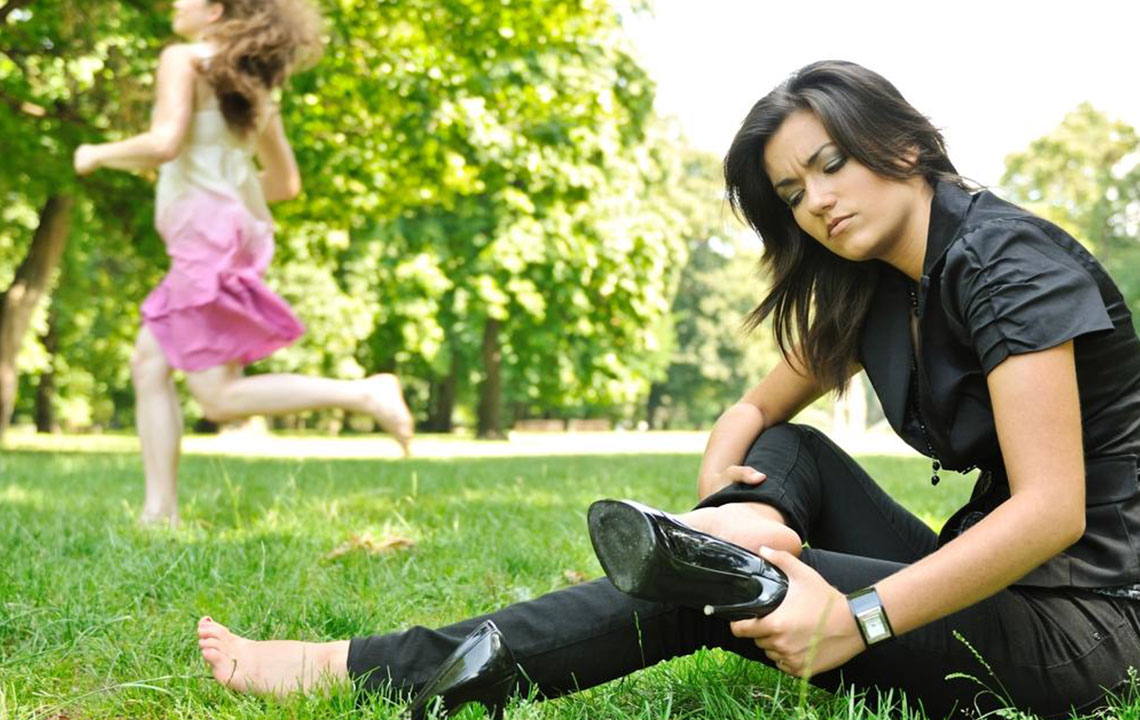Symptoms and Treatment for Heel Pain

Pain over the back of the heel is a common problem worldwide, and it is usually nothing serious. It is the most common type of foot pain. Posterior heel pain commonly affects the back or underside of the heel. There are a few causes of posterior heel pain. Pain over the back or underside of the heel can cause difficulty in walking, running, and standing. Wearing tight shoes often aggravates the problem. Posterior heel pain is prevalent in older people and overweight people.
Commonly associated symptoms of this condition are swelling, tenderness, redness, and pain in the heel. These signs and symptoms worsen with activity and weight-bearing situations like prolonged standing.
Posterior heel pain is not a diagnosis itself, but instead, it’s a sign of other conditions like plantar bursitis, Achilles tendonitis, etc. Back of heel pain treatment focuses on identifying the underlying cause and relieving pain and discomfort. Back of heel pain treatment involves medication, physiotherapy, and home remedies.
Common causes of posterior heel pain
Back of heel pain treatment depends first and foremost on an accurate diagnosis. Since posterior heel pain is a relatively vague symptom, it has a vast differential diagnosis.
The three main causes of posterior heel pain are commonly called ‘terrible triad.’ They are—Insertional Achilles tendonitis, Retrocalcaneal Bursitis, and Haglund’s deformity.
Insertional Achilles Tendonitis
The Achilles tendon is a long and strong tendon that connects the large muscles of the calf to the heel. It is the largest tendon in the body and is regularly subjected to heavy forces up to 24 times a person’s body weight. Repetitive stress on the Achilles tendon, especially in athletes, causes wear and tear over time. This weakens the Achilles tendon. The Achilles tendon tends to degenerate the most, at its insertional point in the heel called the calcaneus. This degeneration triggers an inflammatory response that causes pain, swelling, and redness over the back of the heel. In chronic cases, the tendon gets calcified with bone-like fragments.
Retrocalcaneal Bursitis
A bursa is a sac containing fluid that helps lubricate any two surfaces that rub against each other. These are found throughout the body and help with mobility. There are several bursae present in the heel that help in smooth movement of tissues present there. Even though bursae are very small, when inflamed, they can swell up remarkably. Inflammation of the bursa is called bursitis. The bursae in the heel are positioned over the Achilles tendon, which helps it glide over the insertion point. A thickening of the heel bones or the Achilles tendon can result in bursitis. In some cases, the bursae become too enlarged that it appears as a visible and palpable bump over the back of the heel.
Haglund’s Deformity
Haglund’s deformity is a bony bump that forms over the back of the heel. The soft tissue over the Achilles tendon calcifies and gets inflamed when the back of the heel rubs on the back of shoes, especially hardback shoes like men’s dress shoes and women’s high heels. This bony prominence develops over time and causes discomfort and irritation to nearby tissues.
Other common causes of posterior heel pain are:
- Tarsal Tunnel Syndrome
- Plantar Fasciitis
- Peripheral neuropathy
- Stress fractures, etc.
Back of heel pain treatment options
There are some options for the back of heel pain treatment.
Heel or shoe lifts
Back of the heel pain treatment can be done with a heel lift. A heel lift will take some of the weight-bearing load off the Achilles tendon while walking. This gives some rest and relief to the tendon, which will help in recovery.
Stretching exercises
Gentle stretching of the Achilles tendon and the calf muscles, can improve the mobility of the leg and relieve the tension in the muscles and tendons. This improves the durability of the tendon.
Non-Steroidal Anti-Inflammatory Agents (NSAIDs)
There are over-the-counter medications that can alleviate the symptoms but does not treat the underlying cause. Back of heel pain treatment with NSAIDs reduces the inflammation and pain.
Weight loss
Reducing the amount of weight being borne on the heel will vastly reduce any strain and pain over the back of the heel. Even a small amount of weight loss has exponential benefits for the back of heel pain treatment.
Surgical back of heel pain treatment
Surgical intervention is the last option for the back of heel pain treatment. All other treatment options must be exhausted first before resorting to surgery since recovery is hard and post-operative success is unreliable. Surgery for the back of heel pain treatment involves removal of the Haglund’s deformity, removal of the inflamed bursa, and debriding the Achilles tendon. In severe cases, the Achilles tendon has to be removed and reconnected, or removed completely and replaced with another tendon, extracted from elsewhere in the body. Surgery puts you at risk of complications like infections, deep vein thrombosis, etc.
Lifestyle changes
Avoiding unnecessary wear and tear on your feet, wear correctly sized shoes, and use supportive devices if necessary.
Heel pain is a painful symptom that can sometimes lead to other syndromes. Visit a doctor for an accurate diagnosis so that you could begin treatment.


